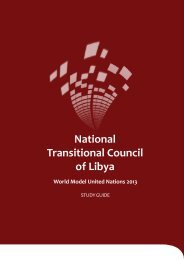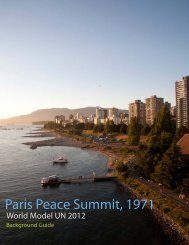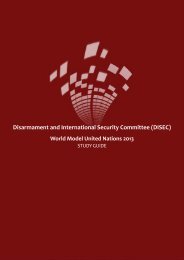SPECPOL - World Model United Nations
SPECPOL - World Model United Nations
SPECPOL - World Model United Nations
Create successful ePaper yourself
Turn your PDF publications into a flip-book with our unique Google optimized e-Paper software.
Similarly, the ability of the <strong>United</strong> <strong>Nations</strong> to act<br />
on behalf of these workers is sufficiently complicated<br />
in its own right. The necessity of action on behalf<br />
of marginalized inhabitants must be tempered with<br />
respect for the sovereignty of a particular nation to<br />
determine its own labor policy and consequently<br />
to address potential weaknesses and oversights of<br />
such a policy. Furthermore, the question of what<br />
specifically constitutes mistreatment of laborers<br />
remains unanswered and presents further difficulties<br />
in instituting any intervention. Finally, while it is<br />
imperative that these issues be addressed, they<br />
must be resolved in such a way as to not discourage<br />
further migration, which has been shown to be<br />
mutually beneficial to both the home country and the<br />
destination. 1<br />
Dubai has, in recent years, been accused of<br />
allowing mistreatment and exploitation of thousands<br />
of workers across many industries. Hopefuls from<br />
india, the Philippines, and Somalia are employed<br />
in the public and private sectors, yet routinely have<br />
had their pay docked or withheld and commonly<br />
are misled about the opportunities that await them<br />
in the city. This situation epitomizes the difficulties<br />
in approaching the problem, for the workers have<br />
often signed contracts, which might have led them<br />
to forfeit many traditional labor rights. Ameliorating<br />
the situation in Dubai requires a new framework<br />
upon which the united <strong>Nations</strong> can construct an<br />
international labor policy.<br />
Complications thus arise from many different<br />
factors. There is no protocol by which abuses might<br />
be identified, and even current definitions fail to<br />
be broad enough to be evenly applied across many<br />
different industries and nations. A course of action for<br />
addressing these problems once identified is similarly<br />
lacking, both for existing situations of exploitation<br />
as well as for stemming the flow of migrant workers<br />
brought in to countries by various agencies. Until such<br />
issues are addressed, migrant workers will continue<br />
to work with fewer rights and decreased protections.<br />
History of the Problem<br />
Globalization and Foreign Labor<br />
The rapid advance of technology following <strong>World</strong><br />
War ii spawned a new era of shared information.<br />
This interchange of global ideas, hastened by the<br />
fall of colonialism, rendered geographic distance<br />
inconsequential for many laborers looking to explore<br />
employm ent opportunities. The rise of working<br />
wages and specialization in developed countries<br />
created a demand for unskilled labor, fostered by<br />
the reluctance of workers within those developed<br />
countries to accept lower wage positions. 2 A<br />
large market for unskilled labor was therefore<br />
developing and, coupled with the increasing speed of<br />
transportation, became a very real target for migrant<br />
workers seeking better opportunities abroad.<br />
the post-<strong>World</strong> War ii climate saw many<br />
opportunities for migration. displaced peoples,<br />
whose livelihoods were destroyed by the war, found<br />
no more opportunities in their home countries and<br />
instead looked abroad. The growing economies of<br />
Western europe and Australia saw large demand for<br />
unskilled laborers, which were easily filled by hordes<br />
of eager immigrants. Across the world, immigrants<br />
flocked to developed nations experiencing a postwar<br />
economic boom, meshing formerly disparate<br />
peoples and cultures. this immigration forged new<br />
connections between countries, allowing new<br />
partnerships and treaties to be signed under the<br />
pretense of allowing speedier immigration. With large<br />
Diasporas now present internationally, the global<br />
exchange of information and traditions between<br />
immigrant groups and natives of the countries in which<br />
they resided expanded. Soon, a global network, built<br />
on the back of technology and migration, connected<br />
geographically distant economies in unprecedented<br />
ways.<br />
Melbourne Host Directorate PTY LTD | Office of Media and Design<br />
9

















